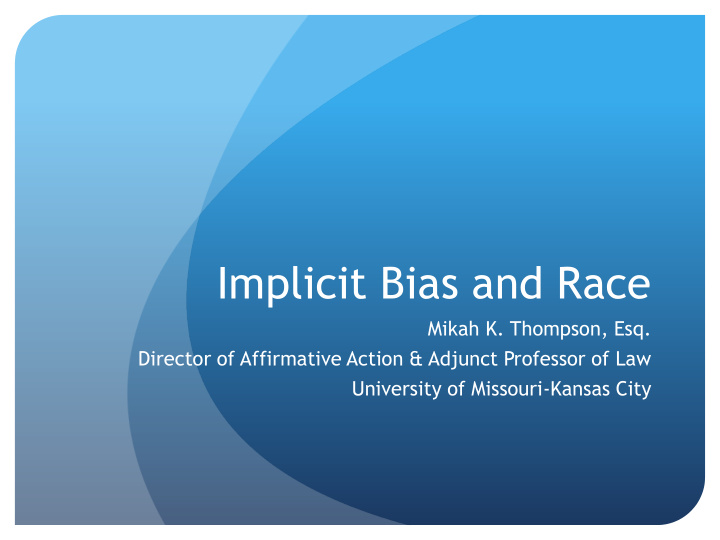



Implicit Bias and Race Mikah K. Thompson, Esq. Director of Affirmative Action & Adjunct Professor of Law University of Missouri-Kansas City
Learning Objectives Define implicit bias Explore the effect that implicit bias has on decision-making Review techniques for reducing or eliminating implicit biases
Defining Implicit Bias
What Is Implicit Bias? “Residing deep in the subconscious, these biases are different from known biases that individuals may choose to conceal for the purposes of social and/or political correctness. Rather, implicit biases are not accessible through introspection. The implicit associations we harbor in our subconscious cause us to have feelings and attitudes about other people based on characteristics such as race, ethnicity, age, and appearance. These associations develop over the course of a lifetime beginning at a very early age through exposure to direct and indirect messages. In addition to early life experiences, the media and news programming are often-cited origins of implicit associations.” (Kirwan Institute for the Study of Race and Ethnicity)
Characteristics of Implicit Bias “Implicit biases are pervasive. Everyone possesses them, even people with avowed commitments to impartiality such as judges.” “The implicit associations we hold do not necessarily align with our declared beliefs or even reflect stances we would explicitly endorse.” “We generally tend to hold implicit biases that favor our own ingroup, though research has shown that we can still hold implicit biases against our ingroup.” “Implicit biases are malleable. Our brains are incredibly complex, and the implicit associations that we have formed can be gradually unlearned through a variety of debiasing techniques.” (Kirwan Institute for the Study of Race and Ethnicity)
Why Discuss Implicit Bias and Race? The evolution of racism, which is marked by: Unintentional racists In-group favoritism, not out-group prejudice Micro-aggressions – “[E]veryday insults, indignities and demeaning messages sent to people of color by well- intentioned white people.” (Derald Wing Sue, et al., 2007) Fewer instances of explicit, overt racism Example – Bias in Children: https://www.youtube.com/watch?v=nFbvBJULVnc
Implicit Social Categories/Cognition FROM Direct or vicarious Parents/Families experiences Friends/Peers Positive or School negative associations Media
Measuring Implicit Bias The Harvard Implicit Association Test (IAT) - https://implicit.harvard.edu/implicit/ IAT categories include: gender-career gender-science age religion weight disability sexuality Asian Native American Arab-Muslim skin-tone race weapons
Stroop Test
Does Implicit Bias Affect Our Decision-Making?
Name Bias in Hiring – Lakisha & Jamal vs. Emily & Greg Fictitious resumes were sent to Boston and Chicago employers. Resumes included stereotypically Black and stereotypically White-sounding names. All qualifications were identical. Researchers found significant discrimination against job applicants with Black-sounding names. Applicants with White-sounding names received 50 percent more call-backs. Advantage for applicants with White-sounding names was equivalent to an additional eight years of experience. (Marianne Bertrand, et al., 2004)
Shooter Bias College students participated in a simulated shooting task in which they saw faces of Black, White and Asian men paired with either a gun or a neutral object. The students had to decide whether to shoot by pressing a button within 630 milliseconds of the appearance of the face. The students shot the unarmed Black men more often than the unarmed Asian and White men. Researchers found that the cultural stereotype of Black criminality contributed to this result. (Saul Miller, et al., 2012)
Bias in Healthcare Physicians took the Harvard Implicit Association Test. Thereafter, the physicians were shown a vignette of a patient, Black or White, who presented with symptoms of acute coronary syndrome. The physicians were asked to diagnose and treat the patient. Researchers found that the physicians showing a bias against African-Americans on the IAT were less likely to subscribe proper treatment to the Black patient. Researchers attributed the difference in treatment to the stereotype that African-Americans are less cooperative with medical procedures and less cooperative generally. (A.R. Green, et al., 2007)
Other Studies Implicit bias affects school discipline decisions, especially for Latino and African-American boys. (Kirwan Institute, 2015) Researchers have found that criminal defendants with Afro-centric features receive with longer sentences. (Irene Blair, et al., 2003) Implicit bias affects perceptions of Arab-Americans and Muslims and associates these groups with terrorism. (Jaihyn Park, et al., 2007)
Reducing the Effects of Implicit Bias
Techniques for Reducing Biased Decision-Making Recognize and remain mindful of your own biases. Take the IAT . Engage in high-effort, deliberate thought processes. Appreciate that making a decision based on your “gut” or intuition” increases the likelihood of bias. Recognize the negative impact of stereotypes. Improve your own critical thinking skills by looking at issues from various perspectives, using a different lens. Take note of the messaging that surrounds you at work and at home. Expose yourself to out-group members to counteract biased messaging and assumptions.
Implicit Bias Resources Kirwan Institute for the Study of Race and Ethnicity, http://kirwaninstitute.osu.edu/ Harvard’s Project Implicit, https://implicit.harvard.edu/implicit/ ABA Section of Litigation’s Implicit Bias Initiative, http://www.americanbar.org/groups/litigation/initi atives/task-force-implicit-bias.html
Recommend
More recommend